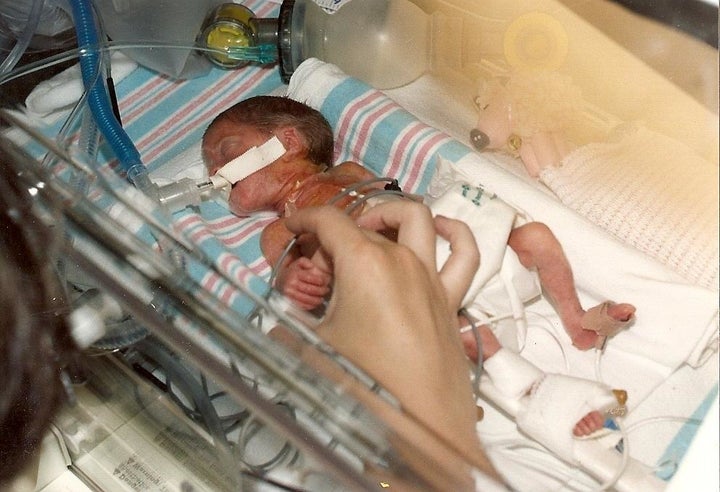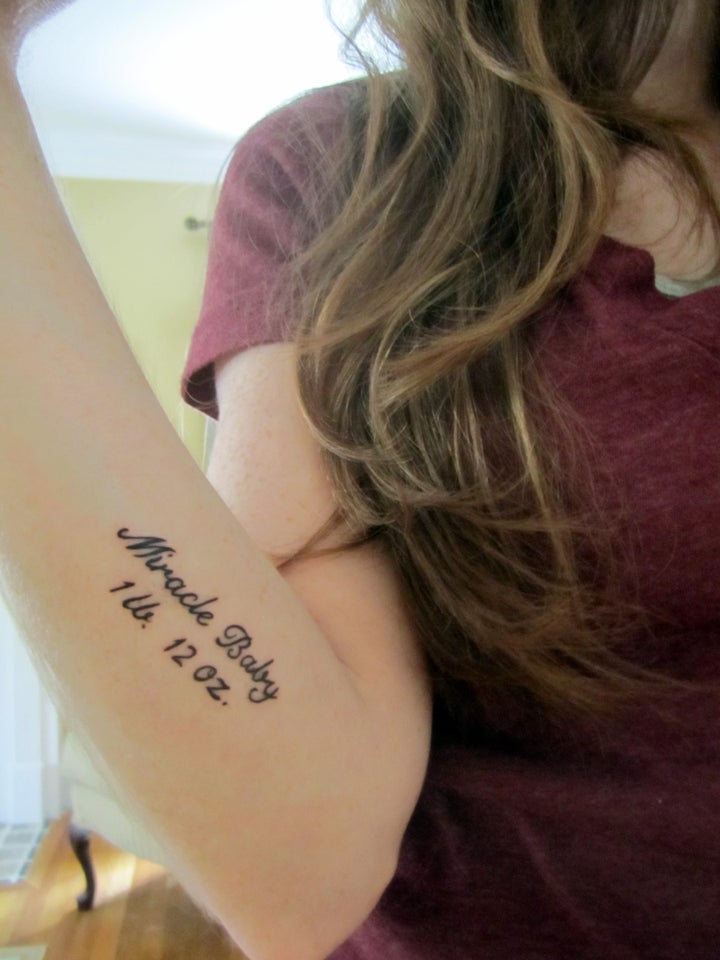
I was born 1 pound, 12 ounces and spent three months in the NICU.
November is Prematurity Awareness Month, but I am reminded every day of premature birth because it’s tattooed on my right arm in cursive.
I was born three months early, weighing 1 pound, 12 ounces, laying the length of a ruler and fitting in the palm of my father’s hand. My parents call me their miracle baby.
I find myself staring at my tattoo in random moments, realizing the struggle I went through and how lucky I am to be alive and relatively healthy at 28. I often think about what it means to be a preemie, how I’m part of this group of fighters.
The doctors told my parents I had a 40/60 chance of living. Babies born at 25 weeks’ gestation didn’t have the odds in their favor in 1988. But I survived. I was fortunate to be cared for in Boston, where technology to save premature infants was more advanced than many cities.
I was in the Neonatal Intensive Care Unit for three months. As soon as I was born, I was intubated with a breathing tube because my lungs were immature. My skin was wrinkled. Tubes ran from my tennis-ball sized head to my feet.
My parents have a Polaroid of me at 6 days old, weighing 600 grams, my head swimming in a cloth hat.
In my brain I had a Grade II Intraventricular Hemorrhage (IVH), where tiny blood vessels covering the brain rupture, causing blood to leak. An IVH is graded as I, II, III or IV. Grade III is typically associated with severe disabilities; Grade IV is often fatal. Grade II can have long-term risks, such as cerebral palsy and learning disabilities. My IVH resolved, but its effects wouldn’t be known until I was older.
My intestines were also immature, so I was fed by IV, consisting of total parenteral nutrition and intralipids. These liquids provide all the nutrients and fats preemies need until stable enough to receive feedings by mouth.
I had retinopathy of prematurity (ROP) of the eyes, a potentially blinding eye disorder, from high levels of oxygen I received. ROP develops in the delicate eye blood vessels. When I was only two pounds I had surgery in order to prevent the overgrowth of these vessels.
My parents say it was my feistiness that helped me survive. Medical science did what it could to help extremely premature infants live, but if you believe in “will to live,” then I had it.
The odds of living were stacked against me and the chances of living with severe disabilities, such as deafness, blindness or brain damage, were high.
While a miracle baby, I did endure struggles while growing that still affect me. As a young girl I wore an eye patch to strengthen my weaker eye. I struggled with, and continue to work with, a slight language-based learning disability that made processing new information difficult.
In early grade school, I struggled academically to learn some basic skills like counting change and telling time. I was eager to learn, but fell behind in reading and writing.
As the curriculum became more challenging, I became more exhausted, especially with large amounts of homework. Writing book reports was also a challenge as I had trouble writing long papers. It wasn’t that I didn’t want to write, ideas just didn’t come easily and my imagination wasn’t as fully developed as other students. Having to focus on learning the day’s lessons was tiring, let alone creating my own ideas.
But as I did when I was born, I had determination and drive. While struggling with book reports and studying lectures, I received study and homework help from a resource teacher in middle school and high school, and used the resources of teacher assistants in college.
With support, I thrived and actually found my love of writing in middle school. I graduated from one of the top high schools in Massachusetts, earned a bachelor’s from Champlain College and a master’s from New York University. I currently work at a large media company.
It wasn’t until two years ago that I went searching. I started reading stories online from parents of other preemies. I wanted to read about other experiences and understand, as much as I could, how blessed I really am.
I read about the March of Dimes and began donating. I am connected to this group of warriors across the world, from babies being born today to survivors of all generations.
Fifteen million babies worldwide are born prematurely each year, before 37 weeks, and tragically one million will die. Not only during Prematurity Awareness Month and on World Prematurity Day (Nov. 17) am I reminded of this, but every time I see my tattoo.
Among the truth of loss in premature birth, I want people to know that miracles like me do survive and thrive. I hope people continue learning about premature birth, like I am. I hope people donate. I hope survivors and families continue to share their stories.
And I hope that every day the word is spreading to reduce the number of premature births and increase the number of healthy survivors.

I wanted a tattoo to be meaningful. I got this done in the summer of 2012.